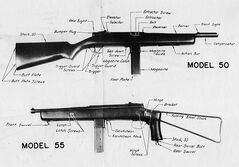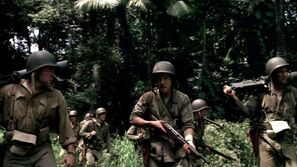
The M50 Reising
The M50 Reising was a submachine gun that was first designed by Eugene Reising in 1940. It appears briefly in the beginning of Part 2 used by John Basilone.
Usage by Marines[]
The Reising Submachine Gun was a weapon unique to the Marine Corps. It was adopted into service in the early stages of World War II when the armed forces were expanding rapidly. Firearms manufacturers were challenged to provide quality weapons in the numbers required by the military services.
The Thompson Submachine Gun had been issued for many years prior to the war and was the standard weapon of its type. As the Army and the Marine Corps ramped up their size to meet the needs of war, there were simply not enough Thompsons available. The Marine Corps began to search for a suitable submachine gun to equip its combat units, especially the new parachute battalions.
Eugene G. Reising was the designer of the gun that bore his name. He had worked closely with John Browning in the development of the M1911 .45 automatic pistol. Later, he was employed by several firearms companies. As World War II flamed in Europe and the Pacific, Reising realized that the armed forces would need large numbers of cheap, easily produced submachine guns.
Receiving a patent for his submachine gun in June, 1940, Reising searched for a manufacturer. The firearms firm of Harrington and Richardson agreed to build the weapons and production began in December 1941. The Army Ordnance Department conducted trials of the Reising gun at Aberdeen Proving Ground in 1941. Accuracy was acceptable, but the gun required constant cleaning to prevent stoppages. The Army chose not to adopt the Reising gun.
The Marine Corps tested the Reising gun sometime late in 1941 at MCB, Quantico. The test board found the weapon to be acceptable when maintained to standards. With little other choice, the Corps adopted the Reising in early 1942. Identified by Headquarters, Marine Corps, as a critical weapon, the Reising was rushed into the hands of Marine units preparing to deploy overseas. It was widely issued to the elite parachute and Raider battalions. But use of the Reising gun was not limited to these units. The new submachine guns were distributed throughout the Fleet Marine Force, especially to the First and Second Marine Divisions. Thousands of Reising guns went with Marine units embarked to the campaigns of the Solomon Islands.
The Reising gun was chambered for the .45 ACP round. Three different models were produced. The Model 50 was outfitted with a fixed wood stock and muzzle compensator. The Model 55 was issued with a collapsible wire stock and no compensator. Both of these models were equipped with 11 inch barrels. The Model 60, which was issued in very limited numbers, had a 18 inch barrel and was semi-automatic only.
The Reising gun was a complex weapon manufactured with tight tolerances. This caused significant problems from the start of its service on Guadalcanal. The magazines were poorly constructed and prone to rusting. Sand and powder fouling made it impossible to rely on the guns in combat, since Marines were often not able to perform regular maintenance.
In combat, the Reising gun quickly developed a reputation for failing at the worst moments. Some outfits simply threw away their Reisings into the rivers and streams on Guadalcanal and issued rifles in their place. Many Gyrenes simply replaced their Reisings by 'moonlight requisitioning,' especially after M1-equipped Army units began arriving on the island. In the story of the 1st Raider Battalion in World War II, historian Joseph Alexander noted some of the Reising gun's issues:
"It was four pounds lighter than the Thompson, and because it fired from a closed bolt the weapon was uncommonly accurate for a submachine gun. But the Reising could not sustain heavy combat use in the jungle. So tightly designed were the tolerances between its bolt and locking recesses the the weapon would frequently malfunction amid the slightest dirt or debris. Nor could the magazines sustain rough handling. Many troops quickly lost confidence in their reisings. Jumping Joe Chambers dismissed it as "a poor man's Thompson submachine gun." Sam Griffith called it "an absolute dud." Photographs taken of Raiders after the Battle of the Ridge portray a diminished number of Reisings in evidence."
By early 1943, increased quantities of Thompson submachine guns and M1 carbines were available. The Marine Corps cancelled its contract with Harrington and Richardson that year after about 55,000 Reising guns had been acquired. All Reisings in service with the Fleet Marine Force were withdrawn and replaced with other weapons. The Reising continued to equip Ships' Detachments, and other posts and stations of the Corps. Shortly after the end of World War II, all models of the Reising gun were declared obsolete and disposed of.


